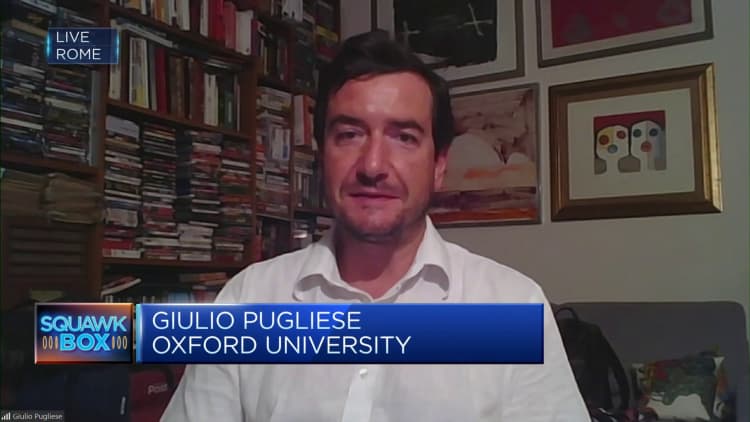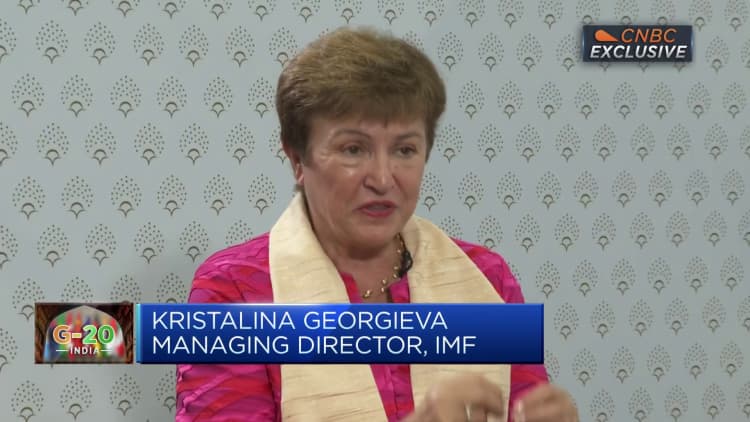Biden backs financial hall as geopolitical alliances fragment globe
Saudi Arabia’s Crown Prince and Prime Minister Mohammed bin Salman (L), India’s Prime Minister Narendra Modi (C) and US President Joe Biden attend a session as a part of the G20 Leaders’ Summit on the Bharat Mandapam in New Delhi on September 9, 2023.
Ludovic Marin | Afp | Getty Pictures
NEW DELHI — Even for these accustomed to the ebbs and flows of the U.S.-Saudi Arabia relationship, the sight of President Joe Biden extending a handshake to Saudi Crown Prince Mohammad bin Salman on the current G20 leaders’ summit in New Delhi was fairly the turnaround.
In any case, Biden had warned final October of “penalties” after the Saudi-led oil cartel OPEC determined to chop crude manufacturing and increase costs amid Russia’s struggle in Ukraine.
Roughly a 12 months on, Saudi Arabia shouldn’t be solely certainly one of six new invitees to the China-dominated BRICS coalition, but additionally a signatory to the Biden-led pact for a ship-to-rail financial hall linking India with Center Japanese and European Union nations unveiled on the sidelines of the G20 summit — framed as a counter to China’s decade-old Belt and Street Initiative.
Saudi Arabia’s double dipping underscores the vary of financial and strategic alternatives that abound for the assorted economies caught between the dueling U.S. and China as they construct their very own alliances and spheres of affect. U.S. and different main Western nations have been eager to “de-risk” their financial — and never decouple — from China on grounds of nationwide safety.
That is additionally consequently resulting in a fragmentation of the world’s economic system as protectionism and nationalism impede world commerce, whereas giving rise to a posh matrix of relationships in a multipolar world that aren’t all the time simple as nations pursue their self pursuits.
“We aren’t heading towards a BRICS vs G7 world,” Ian Bremmer, founder and president of political threat consultancy Eurasia Group, wrote in a observe final Monday. G7 refers back to the Group of Seven superior industrialized economies, whereas BRICS refers to a gaggle of main growing economies — each are sub-groups throughout the G20.
“China scored a major victory on the BRICS summit, securing the invites of six further nations to hitch the group — regardless of important considerations from Brazil, India, and South Africa,” he stated.
“However virtually all of the BRICS+ oppose the thought of a China-led group and don’t desire BRICS membership to constrain their present — and most often rising — diplomatic and financial ties with G7 members,” Bremmer stated.
Threat of exclusion
In reality, the better threat and alternative price could now be from any exclusion.
“We are saying there is no such thing as a hall with out Turkey,” Turkish President Recep Tayyip Erdoğan reportedly instructed reporters on the sidelines of the G20 leaders’ summit in Delhi — after it emerged his nation was excluded from the Biden-backed new financial hall.
The attraction, notably for the world’s growing economies, is the promise of funding that will plug infrastructure gaps in low- and middle-income nations. This could in flip safe regional provide chains, increase commerce connectivity and financial exercise — all much like goals underpinning China’s Belt and Street Initiative, a worldwide infrastructure funding technique that Beijing launched in 2013.
“The issue with ‘counter (China’s Belt and Street Initiative)’ is that it’s a U.S. narrative, whereas native narratives are almost all the time about multiplication/addition, not subtraction,” Evan Feigenbaum, a former U.S. diplomat and presently vice-president for research on the Carnegie Endowment for Worldwide Peace, stated on X, previously Twitter.
France’s President Emmanuel Macron, Indonesia’s President Joko Widodo, India’s Prime Minister Narendra Modi, Brazil’s President Luiz Inacio Lula da Silva and US President Joe Biden (L-R) pay their respects on the Mahatma Gandhi memorial at Raj Ghat on the sidelines of the G20 summit in New Delhi on September 10, 2023.
– | Afp | Getty Pictures
This Biden-led initiative will comprise of two separate corridors, the east hall connecting India to the Center East and the northern hall connecting the Center East to Europe. It’s going to embrace a railway that may complement present cross-border maritime and street transport routes between India, the UAE, Saudi Arabia, Jordan, Israel, and Europe.
“It is a massive deal. It is a actual massive deal,” Biden stated in Delhi on the launch.
Biden additionally introduced a partnership with the European Union in a brand new greenfield rail line growth to develop the Lobito Hall connecting the southern a part of the Democratic Republic of the Congo and northwestern Zambia to regional and world commerce markets by way of the port of Lobito in Angola.
Center East affect
China’s BRI presents a glimpse into Biden’s ambition and maybe what his infrastructure pact will come up in opposition to.
Since its launch 10 years in the past, Beijing’s BRI now counts 148 nations as companions, in keeping with a tally by Fudan College in Shanghai. The BRI is more likely to increase world GDP by $7.1 trillion every year by 2040, in keeping with a 2019 examine by the impartial Heart for Economics and Enterprise Analysis in London.

The worth of acquisitions and investments by Gulf corporations in China in on observe for its finest ever, having already climbed greater than 1,000% year-on-year to $5.3 billion, in keeping with knowledge compiled by Bloomberg.
China’s rising involvement in political and safety points is testomony of this rising clout with its Gulf companions. The Saudi-Iran normalization settlement, for instance, was brokered in Beijing.
Biden’s infrastructure pact chopping via the center of the Center East is a method the U.S. is trying to reboot its affect within the area once more.
Debt dangers
Even then, China’s 10-year head begin presents some cautionary classes for Biden’s world infrastructure pact.
BRI offers between China and varied accomplice nations usually contain a set of loans both with multilateral banks, that Beijing exerts heavy affect on, or with Chinese language state or coverage banks at about 4-5% rates of interest — which is often increased than the IMF, the place loans are typically prolonged to low-income nations at zero p.c.
BRI offers additionally normally embrace building and gear by Chinese language corporations, that are largely state-owned.
“Debt points apart, large-scale infrastructure initiatives are typically excessive threat. Furthermore, returns are likely to get realized in the long run and should not even accrue to the unique investor,” stated Chong Ja Ian, an affiliate professor in political science on the Nationwide College of Singapore.

“Therefore, it’s normally public monies that fund large-scale infrastructure, since they make much less industrial sense for personal companies involved with earnings in addition to quarterly and even annual outcomes,” he added. “That is particularly the case for the initiatives the PRC [People’s Republic of China] invested in as a part of the BRI. The dearth of funding beforehand needed to do with weak industrial circumstances for funding.”
Based on New York-based consultancy Rhodium Group, about $78.5 billion of loans issued by Chinese language establishments to fund infrastructure initiatives world wide had been renegotiated or written off between 2020 and the tip of March this 12 months.
The Worldwide Financial Fund and the World Financial institution have been concerned in a few of these negotiations, pointing to a marginal shift to China’s willingness to contain multilateral banks in debt restructuring negotiations.
“25% of debt of rising markets is treading in distressed territory,” IMF’s Managing Director Kristalina Georgieva instructed CNBC on the sidelines of the Delhi G20 leaders’ summit.
Strategic various
The difficulty has gotten critical sufficient that U.S. Treasury Secretary Janet Yellen ranked it excessive on her agenda along with her Chinese language counterparts on her go to to Beijing in July and once more at this G20 assembly in Delhi.
“I assume you’ll be able to say that Washington and Delhi are attempting to current another,” Chong stated.
“The hall appears extra centered on linking present ports and railway strains, supplemented by vitality grids and telecommunications cables,” he added. “This seems to be a decrease threat method and should even make use of infrastructure already paid for and constructed beneath the auspices of the BRI.”

Extra particulars of Biden’s India-Center East-Europe infrastructure plan will likely be made accessible after taking part nations meet, however his plan is already seen as a wise maneuver across the more and more nationalistic sentiment that’s limiting extra commerce liberalization within the U.S.
“Many states would really like entry to the U.S. market, however U.S. home politics appears to make such developments tougher nowadays,” Chong, the NUS affiliate professor, stated.
“Stressing connectivity and funding is a means for america to beat the challenges it presently faces domestically with commerce liberalization,” he added.
Rise of the center powers
Within the meantime, Biden’s workaround and constructing of a coalition of allies are giving India Prime Minister Narendra Modi the room to style itself because the chief of the growing world, selecting the time period “International South” as his alternative reference.
In a banner 12 months for Indian diplomacy that additionally noticed the world’s most populous nation tackle the rotating presidency of Shanghai Cooperation Group, Modi took the chance to show the usually sedate rotating G20 presidency right into a branding automobile to burnish India as a key world participant advocating the pursuits of the International South, whereas serving as an interlocutor with the developed nations.

“Partly that is a response to most nations in [G20] being upset at america (and to various levels, the broader West) over unilateralism and lack of fairness in coverage within the financial, pandemic, local weather, and safety spheres,” Eurasia Group’s Bremmer stated.
He added many countries are additionally upset with China over “diminished expectations in Belt and Street and a very transactional and aggressive method towards industrial leverage.”
The sudden consensus on the G20 leaders’ summit, together with Modi co-fronting the launch of Biden’s world infrastructure initiative in Delhi, underscore the rising partnership between India and the U.S. within the latter’s broader Indo-Pacific technique to comprise China.
But regardless of the overt calls towards “One Earth, One Household, One Future” on the Delhi summit, the truth is a extra fragmented one as provide chains are aligning alongside shifting world geopolitical strains — when the specified final result for better prosperity for all would contain a better collaboration.
“In a world the place we realized from Covid and the [Ukraine] struggle, that provide chains have to be strengthened, they have to be diversified, that connectivity issues tremendously,” IMF’s Georgieva instructed CNBC.
“What’s necessary is to do it for the advantage of everyone, and never for exclusion of others,” she stated. “In that sense, I might encourage all nations working collaboratively with one another to take action within the spirit of built-in economic system.”




